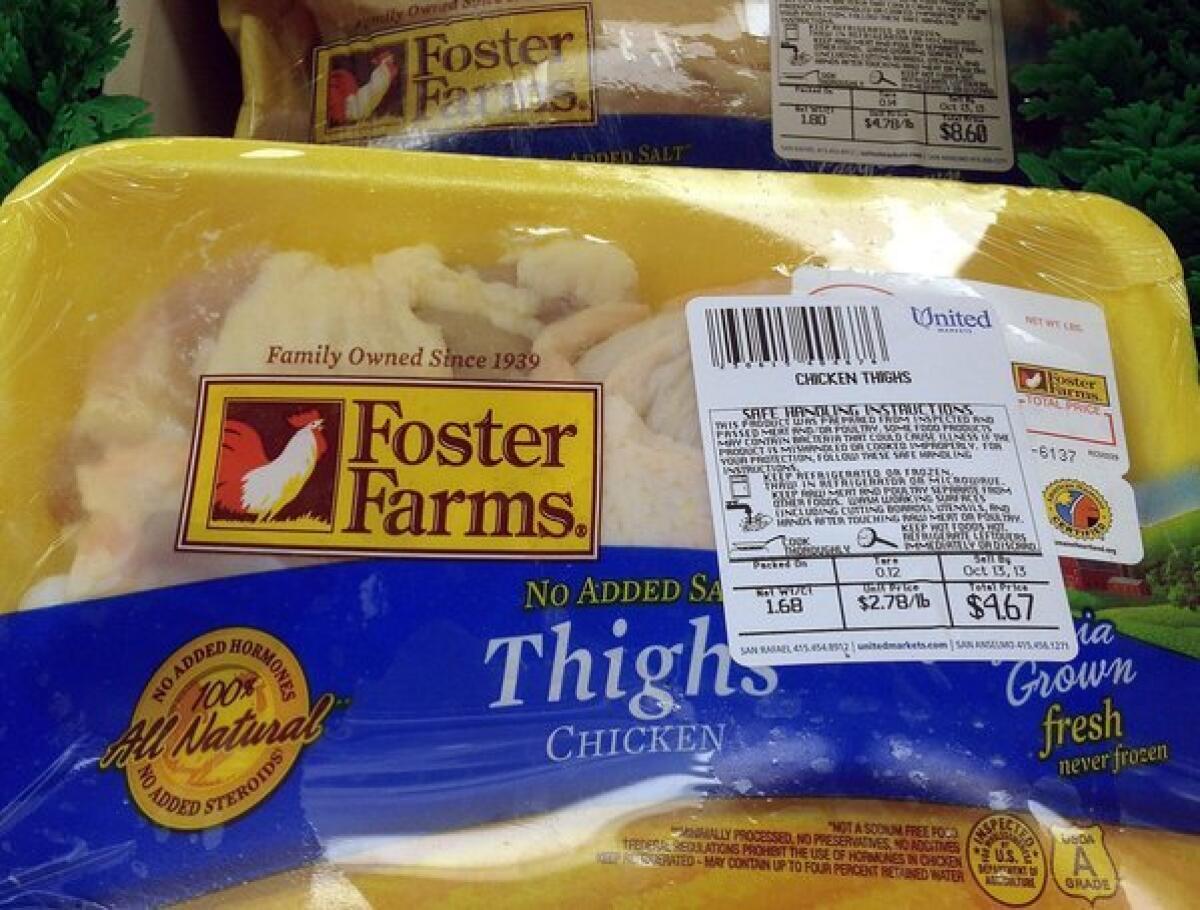Keeping salmonella out of chicken

Sweden has virtually eliminated salmonella in store-bought chicken, even though poultry there is industrially produced, just like in the United States. And even in this country, a 2010 Consumers Union study found no salmonella in the organic store-brand chickens it tested.
In other words, consumers shouldn’t have to accept salmonella-tainted chicken as just one of those unavoidable things. Yet that wasn’t the attitude of Foster Farms and the U.S. Department of Agriculture in response to the recent salmonella outbreak that sickened more than 300 people, most of them in California, and sent close to half to hospitals with antibiotic-resistant infections. Foster Farms refused to recall the suspect chicken shipped from its problem plants, saying that salmonella-tainted poultry is safe to eat if thoroughly cooked. The USDA refused to close the plants on the grounds that, unlike certain strains of E. coli, salmonella is not an adulterant, a poisonous or harmful substance.
It’s true that thorough cooking kills the bacteria, but if the response to antibiotic-resistant salmonella in chicken is “just cook it,” why bother to track outbreaks that can and do cause serious illness and even death? Most consumers already know that chicken is supposed to be handled carefully and cooked until there is no red at the joints or pink juice, yet hundreds were sickened anyway. For that matter, Costco, which sold rotisserie chickens from Foster Farms plants at its stores, recalled tens of thousands of pounds of poultry after finding salmonella even in the cooked meat. It’s unclear how that happened: Could the chicken not have been cooked thoroughly? Must these particular strains of salmonella be heated to even higher temperatures to kill them? Or was there cross-contamination, with cooked chickens exposed to raw? In any case, the Costco situation illustrates the folly of the poultry industry pretending that a problem with its production methods is actually a problem of careless consumers.
It’s especially jarring considering that the Consumers Union’s testing found rates of salmonella contamination in Foster Farms chicken to be higher than in other major brands: 29%, compared with 6% for Perdue and 7% for Tyson.
Home cooks might not heat chicken long enough, unaware of joints that are still too pink. Grocery shoppers might put their lettuce or other raw ingredients on the same checkout conveyor belt where some drippy chicken had just been. Shoppers who don’t wash their reusable bags might contaminate future purchases. At home, they might unwrap the chicken in the sink and then not scrub the sink well enough. They might rub the chicken with spices and herbs, contaminating the paprika jar, the sage jar, the salt shaker and the spice rack itself unless they wash their hands well at each step in the process. If they rinse the chicken before preparing it, which many people still believe to be a smart move despite federal warnings to the contrary, they spread any bacteria yet further, especially when the water sprays off the chicken and onto the counter and backsplash.
Sweden’s example has made it abundantly clear that consumers don’t have to turn their kitchens into hospital operating rooms to prepare and eat chicken safely. That country’s inspection process includes testing at multiple key production points, starting at the hatchery. Any infected eggs or animals must be destroyed; then, inspection and cleanup procedures prevent contamination of equipment or other animals. Nothing is shipped from a facility where salmonella has been found until all animals are inspected and declared salmonella-free. The entire process is paid for by the poultry industry.
In addition, Sweden does not allow poultry operations to fight salmonella with the preventive use of antibiotics, which has been linked to the rise of resistant strains. The rates of resistant salmonella are far lower in Sweden.
For too long in the United States, the agriculture industry has successfully pushed and prodded Congress and regulatory agencies into accepting practices that are literally sickening to the public. At minimum, we could begin to improve food safety by declaring salmonella an adulterant so that the USDA and agricultural operations are compelled to recall infected products.
More to Read
A cure for the common opinion
Get thought-provoking perspectives with our weekly newsletter.
You may occasionally receive promotional content from the Los Angeles Times.










